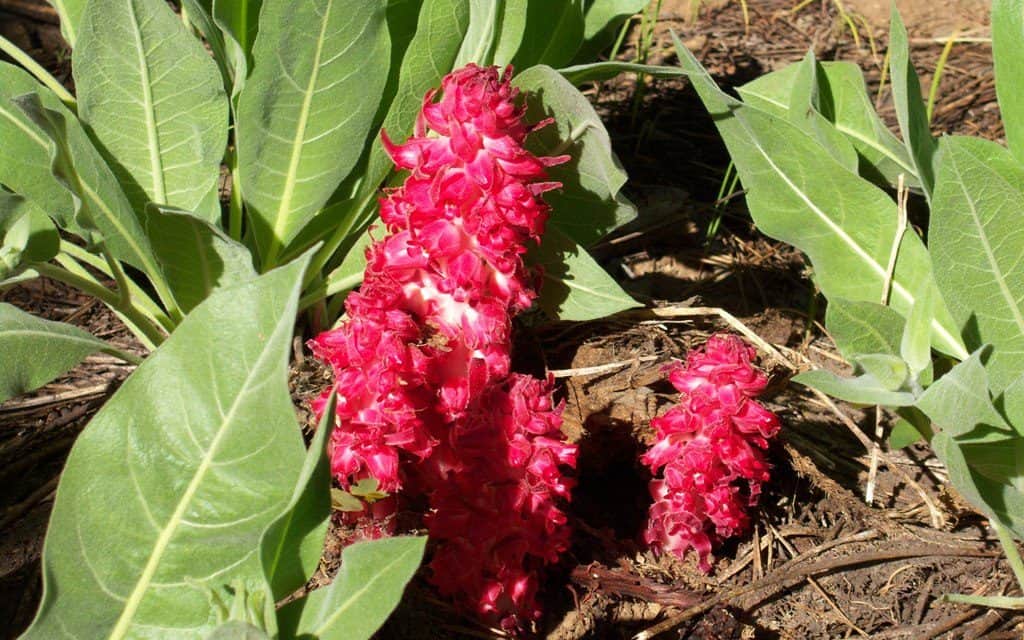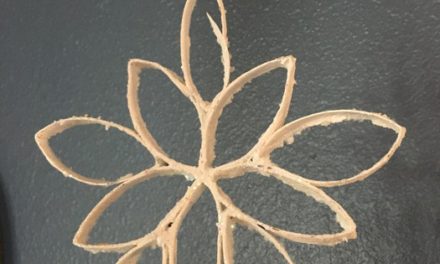By Melissa Wynn
One of the many benefits of living in the higher elevations, is that our wildflower season lasts all summer long. Nature’s mountain garden is sometimes slow to start but as soon as the snow starts melting, the wildflowers begin to add splashes of color to the evergreen forest.
[media-credit id=4 align=”alignleft” width=”300″]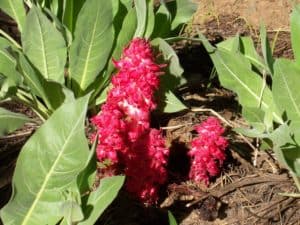 [/media-credit]One of the earliest bloomers is the spectacular, bright red Snow Plant. This amazing plant has no chlorophyll and therefore has no greenery. The entire almost cone shaped plant is brilliant red and appears somewhat unreal. There is no confusing this lover of the high altitude forests with any other plant. Growing up through the last of the snow in the shade of the conifers, is common practice for the Snow Plant and the contrast is quite startling. I saw my first snow plant on a visit to the Gold Lake Lodge in the Lakes Basin Recreation Area around Graeagle. It instantly became my favorite local wildflower. The Snow Plant is rare and protected, so NEVER pick a snow plant. Bring your camera to capture the beauty, but leave the Snow Plant as you found it.
[/media-credit]One of the earliest bloomers is the spectacular, bright red Snow Plant. This amazing plant has no chlorophyll and therefore has no greenery. The entire almost cone shaped plant is brilliant red and appears somewhat unreal. There is no confusing this lover of the high altitude forests with any other plant. Growing up through the last of the snow in the shade of the conifers, is common practice for the Snow Plant and the contrast is quite startling. I saw my first snow plant on a visit to the Gold Lake Lodge in the Lakes Basin Recreation Area around Graeagle. It instantly became my favorite local wildflower. The Snow Plant is rare and protected, so NEVER pick a snow plant. Bring your camera to capture the beauty, but leave the Snow Plant as you found it.
[media-credit id=4 align=”alignleft” width=”300″]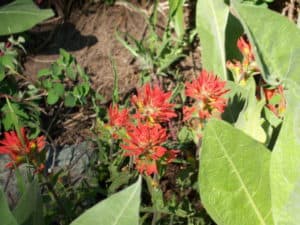 [/media-credit]Indian Paintbrush in many varieties are common across the US and our neighborhood is no exception. Ranging in colors from pale orange to brightest red these familiar favorites are sure to be seen almost anywhere you wander in searching wildflowers. Indian Paintbrush is the state flower of Wyoming. An old legend says that a young Indian brave once painted the sunset with paintbrushes he was gifted by the Great Spirit. The brushes came in all the same colors as our paintbrush wildflower. When the brave completed his masterpiece in the sky, he left his brushes scattered across a field. The first Indian Paintbrush plants of natures garden then sprang to life, there among the magic.
[/media-credit]Indian Paintbrush in many varieties are common across the US and our neighborhood is no exception. Ranging in colors from pale orange to brightest red these familiar favorites are sure to be seen almost anywhere you wander in searching wildflowers. Indian Paintbrush is the state flower of Wyoming. An old legend says that a young Indian brave once painted the sunset with paintbrushes he was gifted by the Great Spirit. The brushes came in all the same colors as our paintbrush wildflower. When the brave completed his masterpiece in the sky, he left his brushes scattered across a field. The first Indian Paintbrush plants of natures garden then sprang to life, there among the magic.
[media-credit id=4 align=”alignleft” width=”300″]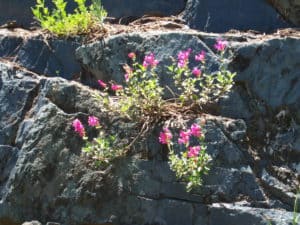 [/media-credit]Natures mountain garden was landscaped by volcanoes so rocky places abound. You wouldn’t think there would be many wildflowers in the rocks but the Mountain Penstemon would beg to differ. These woody stemmed, bright pink beauties thrive in gravel and even up high on rocky cliffs. Blooming June through August Mountain Penstemon dot the mountain sides with brilliant color all summer long.
[/media-credit]Natures mountain garden was landscaped by volcanoes so rocky places abound. You wouldn’t think there would be many wildflowers in the rocks but the Mountain Penstemon would beg to differ. These woody stemmed, bright pink beauties thrive in gravel and even up high on rocky cliffs. Blooming June through August Mountain Penstemon dot the mountain sides with brilliant color all summer long.
[media-credit name=”photo courtesy of the National Park Service nps.gov” align=”alignleft” width=”300″]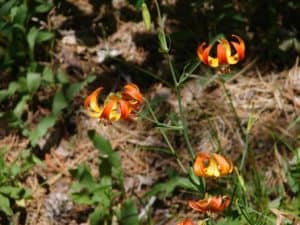 [/media-credit]Leopard Lily is one of California’s most conspicuous lilies. Bright orange with “leopard ” spots are sure to get noticed in the evergreen forest. Not only are these droopy headed blossoms loud in color they are also stand tall. A hearty stem allows these lovely lilies to reach heights over seven feet. Leopard Lilies like the water and grow in colonies along stream banks. These spectacular spotted wildflowers grow from bulbs that are edible. Native Americans dug the bulbs and steamed them. The bulbs are also eaten by various mountain mammals.
[/media-credit]Leopard Lily is one of California’s most conspicuous lilies. Bright orange with “leopard ” spots are sure to get noticed in the evergreen forest. Not only are these droopy headed blossoms loud in color they are also stand tall. A hearty stem allows these lovely lilies to reach heights over seven feet. Leopard Lilies like the water and grow in colonies along stream banks. These spectacular spotted wildflowers grow from bulbs that are edible. Native Americans dug the bulbs and steamed them. The bulbs are also eaten by various mountain mammals.
[media-credit name=”photo courtesy of National Park Service nps.gov” align=”alignleft” width=”224″]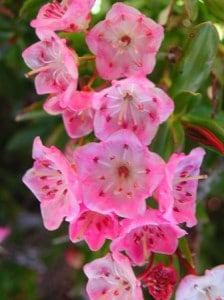 [/media-credit]Bog Laurel is a small flowering shrub that , like the name indicates makes its home in marshy forest bogs. Pretty pink or purple flowers open their petals in late spring bringing some bling to the bog. Bog Laurel is slow to grow but long to live. After twenty years of growing the little bouquet of shrubbery may only be one foot tall. The bogs are home to several special plant species so looking for the Bog Laurel is sure to lead to many sensational wildflower finds.
[/media-credit]Bog Laurel is a small flowering shrub that , like the name indicates makes its home in marshy forest bogs. Pretty pink or purple flowers open their petals in late spring bringing some bling to the bog. Bog Laurel is slow to grow but long to live. After twenty years of growing the little bouquet of shrubbery may only be one foot tall. The bogs are home to several special plant species so looking for the Bog Laurel is sure to lead to many sensational wildflower finds.
[media-credit name=”photo courtesy of National Park Service nps.gov” align=”alignleft” width=”224″] [/media-credit]The open meadows of nature’s garden are home to sometimes vast expanses of the sunny Mule Ears. Large varnished looking leaves shaped like mule ears give the plant its funny name. In May and June Mule Ears burst bright yellow, sunflower like blossoms stretching above the leaves on long stems. Growing one to three feet high Mule Ears are easy to spot. These blazing drops of meadow sunshine are one more wildflower reason to wander nature’s garden.
[/media-credit]The open meadows of nature’s garden are home to sometimes vast expanses of the sunny Mule Ears. Large varnished looking leaves shaped like mule ears give the plant its funny name. In May and June Mule Ears burst bright yellow, sunflower like blossoms stretching above the leaves on long stems. Growing one to three feet high Mule Ears are easy to spot. These blazing drops of meadow sunshine are one more wildflower reason to wander nature’s garden.
.wildflower.org
gardenguides.com

